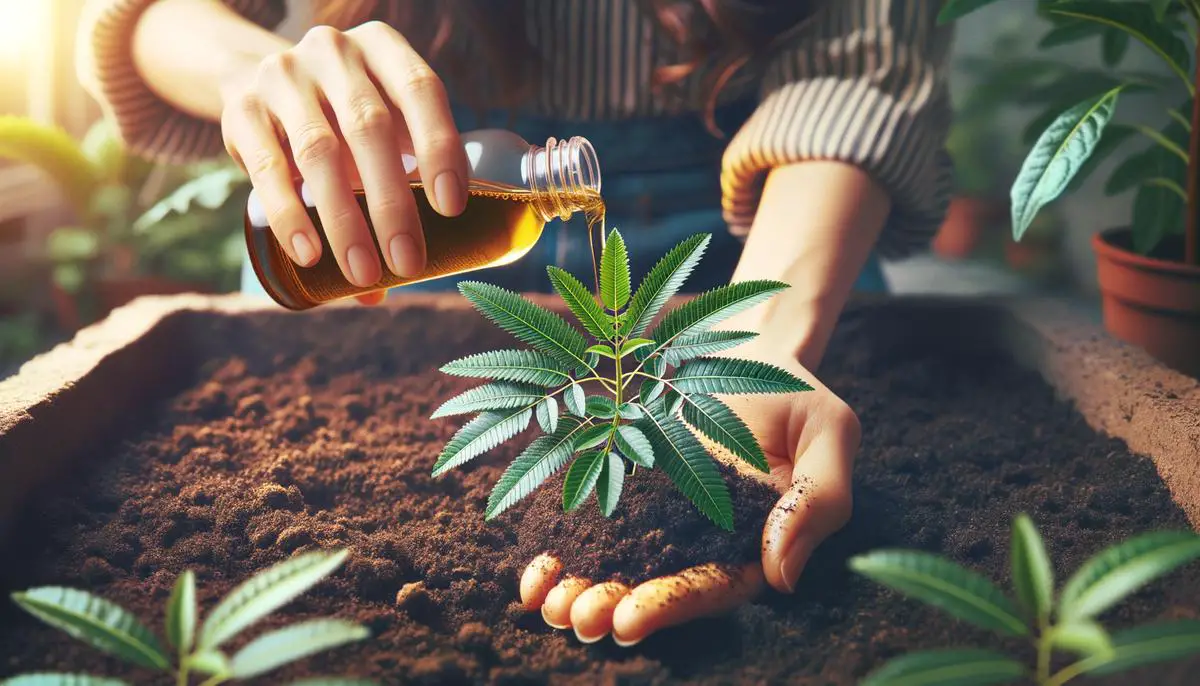Neem Oil as a Soil Drench: Effective Strategies and Application Techniques

In the quest for sustainable gardening practices, neem oil emerges as a beacon of hope for those dedicated to preserving the delicate balance between nurturing plant life and managing pest populations. Neem oil, derived from the seeds of the Azadirachta indica tree, offers an eco-friendly and effective solution for pest management.
Understanding Neem Oil
Neem oil, sourced from the seeds of the neem tree (Azadirachta indica), is a powerhouse in the organic gardening world. Its pest-fighting abilities have garnered attention from gardeners and farmers seeking a safer, environmentally friendly alternative to synthetic chemicals.
The effectiveness of neem oil against a wide array of pests is largely due to its active component, azadirachtin. Azadirachtin disrupts the life cycle of pests, preventing them from reaching maturation or multiplying. Neem oil is also rich in other bioactive components that contribute to its ability as a broad-spectrum pest deterrent, safeguarding plants against voracious eaters like aphids and mites and warding off fungal afflictions such as powdery mildew.
When applied as a soil drench, neem oil offers an additional avenue for protecting plants. As plants absorb the neem oil solution through their roots, they incorporate the protective qualities into their system. This systemic protection means that pests are deterred not just from the outside but from within the plant as well.
While neem oil combats harmful pests, it generally spares beneficial insects when used judiciously. Beneficial insects, such as bees and ladybugs, typically do not ingest the leaves or sap of plants, the primary way in which neem delivers its pest-fighting properties.
The growing preference for eco-friendly gardening practices has thrust neem oil into the spotlight, showcasing it as a model for what natural pest solutions can achieve. Beyond its pest-fighting prowess, neem oil breaks down naturally in soil and water, avoiding the long-term chemical residue associated with traditional pesticides.

Preparation and Application
To ensure your plants receive the full benefits of neem oil through soil application, creating the right mixture is crucial. Here’s a straightforward guide to preparing neem oil for soil drenching, focusing on achieving the perfect balance for maximum efficiency while ensuring safety for your plants.
Materials Needed:
- Pure, cold-pressed neem oil
- Mild liquid soap or a suitable emulsifier
- Water
- Measuring spoons
- A mixing container or spray bottle
Step 1: Emulsify the Neem Oil
Begin by measuring out 1 teaspoon of liquid soap. Soap acts as an emulsifier, breaking down the oil into smaller droplets that can easily mix with water.
Step 2: Prepare the Water
For soil application, a gallon of water will provide an adequate volume for coverage around a standard garden plant. Adjust the volume depending on the size of the area or the number of plants you’re treating. Use room temperature water to aid in mixing the oil and water more effectively.
Step 3: Mix Neem Oil into the Solution
Add 1 to 2 teaspoons of neem oil to the water. The exact amount depends on the pest pressure and the plant’s sensitivity.
Step 4: Combine Oil and Water Mixture
Pour the teaspoons of liquid soap into your gallon of water, followed by the neem oil. Close your container tightly and shake well for a few minutes to ensure the soap, oil, and water are thoroughly mixed. The solution should appear slightly cloudy or milky — a sign that the oil has been successfully emulsified.
Step 5: Apply to Soil
Carefully pour your neem oil mixture onto the soil around the base of your plants. Drench the soil evenly so that the solution can reach the roots, where it’s absorbed and transported throughout the plant. Avoid splashing or direct contact with leaves to minimize any risk to beneficial insects.
Additional Tips:
- Early morning or late evening applications can reduce potential impacts on beneficial insects who are less active during these times.
- Repeat applications may be necessary, especially after rain.
- Monitor plant reaction to adjust concentration if necessary.
With these easy steps, your garden will continue to thrive, benefiting from the natural protection that neem oil offers without sacrificing the safety of the environment or beneficial organisms.

Monitoring and Management
After applying the neem oil mixture to your plants and soil, closely monitoring the effects is vital for ensuring the health of your garden. Here, we will delve into how to observe the outcomes of neem oil application, recognize signs of success, understand potential setbacks, and manage them for flourishing plants.
Monitoring the Effects: Start observing your plants 24 to 48 hours after the application of neem oil. Look for a reduction in pest activity, particularly on the underside of leaves and near the stems. Note any changes in the health and appearance of your plants. Signs of success include vibrant foliage and a noticeable decrease in the presence of pests.
Identifying Signposts of Success: Fewer pests within days of treatment is a clear indicator that the neem oil is performing its expected functions. An improvement in the overall health of your plant’s leaves, such as increased lushness or recovery from previous pest-induced damage, signifies that the systemic protection from neem oil is taking effect. These positive outcomes reflect the pest management capability of neem oil and its ability to enhance plant resilience.
Adverse Reactions: While neem oil is generally safe for plants, incorrect dilution or overuse can lead to adverse effects, such as leaf burn. If you notice any wilting, browning, or drying out of the leaves, this may indicate that the concentration of neem oil was too high or the plant is particularly sensitive. It’s crucial to dilute the solution properly and test it on a small section of the plant before full application.
Managing Setbacks: Should you encounter negative reactions, reduce the frequency of neem oil application and provide your plants with plenty of water to help dilute the concentration around the roots. Assessing your plants and adjusting the care regime is crucial for their recovery.
Ongoing Care and Maintenance: Consistent monitoring will guide you in administering the right amount of neem oil and provide insights into your plant’s specific needs. Regularly check your plants for signs of new or lingering pest infestations and apply neem oil accordingly. Remember, neem oil is best used as a preventive measure rather than a one-time solution. Integrating it into your regular gardening practice can enhance plant vitality.
By recognizing and adjusting to how your garden responds, you can use neem oil responsibly and effectively, ensuring both the safety and prosperity of your plants. Keeping the ecosystem in your garden balanced is a delicate task, but with careful monitoring and management, you can support a vibrant and thriving natural space.

At its core, the use of neem oil in gardening is a commitment to fostering an environment where plants can thrive without reliance on synthetic chemicals. As we continue our gardening endeavors, let us remember that embracing natural solutions like neem oil is pivotal in our journey towards creating more sustainable and harmonious ecosystems.
- Schmutterer H. Properties and potential of natural pesticides from the neem tree, Azadirachta indica. Annu Rev Entomol. 1990;35:271-297.
- Isman MB. Botanical insecticides, deterrents, and repellents in modern agriculture and an increasingly regulated world. Annu Rev Entomol. 2006;51:45-66.
- Lokanadhan S, Muthukrishnan P, Jeyaraman S. Neem products and their agricultural applications. J Biopest. 2012;5(Supplementary):72-76.
